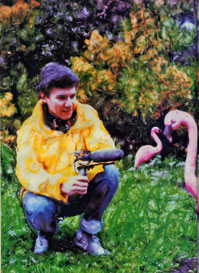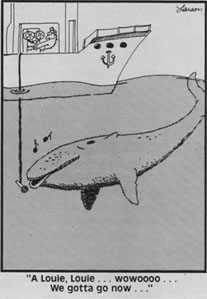|
|
Making Music with
|
|
At 50, Bernie Krause has been immersed the field of electronic music for a quarter century. He appeared on the first commercial album to feature synthesizer (The Zodiac, 1967) and with his late partner, Paul Beaver, was instrumental in introducing the synthesizer to popular music through personal appearances and guest spots on over a hundred albums. He has done soundtrack work for more than 160 films and television shows. In 1981, he returned to college and gained a Ph.D. in bioacoustics. In addition, he is often called upon as a consultant and expert witness on recording and editing technology. Most recently, Krause collaborated on two "instrumental dance singles, "Fish Wrap" (with Matt Ward and Scott Singer) and "Jungle Shoes" (with Matt Ward, Tony Mills, Frank Martin, and Peter Michael Escovido), for the Rykodisc label. Both efforts used only sampled, biological sounds. These singles have brought Krause much media attention, helping him get his message across. That message is the driving force in his lift these days. In an effort to reach out to people-especially school children-who might not hear his environmentalist message or his other music, Krause decided, "If you can get them dancing in the aisles, it will break the ice, and you can hit them with all the environmental stuff you want." Making Nature Come Alive Paul Winter and I were talking about recording his group in the Grand Canyon to try to capture the spirit, if you will, of the p1ace through microphones. I have problems with that, because the minute you extract a quality from the environment and send it to tape, it's no longer what it was. Even the best mic never picks up the true ambience of a place. So you have to use the studio to reposition the sounds in such a way that they come alive and acquire the dimension and lyricism that's always present in nature." Recording natural sounds takes great patience. When Krause is recording ambient acoustic biospectra (see sidebar, "Acoustical Bio-What?"), he records five-minute samples every hour for 24 hours. He gets as much as time and conditions allow, always impeded by weather, moisture, and endless field problems. In one month of recording the mountain gorillas in Rwanda, Africa (with photographer Nick Nichols), Krause recorded about twenty hours of material to get fifteen usable minutes. On most field projects, Krause works about twenty hours per day, but sometimes, as in Rwanda, he is limited to ten hours by the need to work with guides. The equipment Krause uses falls into three categories: field equipment, his home studio (see sidebar, "The Wild Sanctuary"), and the gear he uses at Spark Studio in Oakland, California, where additional advanced tools are available. The studio gear, including the Emulator II and III samplers, is standard. His field "toys," however, are the critical link without which Krause's work would not be possible; they must resist all kinds of stress. Once, to avoid a charging gorilla, Krause had to dive into the Rwandan underbrush while carrying a full recording rig. Another time, his Nagra tape recorder fell 40 feet from a helicopter. The gear survived both incidents. It's In The Water |
There are many kinds of hydrophones, but Krause has found two that suit his purposes. He uses a B&K 8103 for work that doesn't require a lot of sensitivity, i.e., recording loud sounds that travel far. Its frequency range extends from 0.5 Hz up to about 200 kHz. The cost is around $1,200, with the required B&K amplifier adding about $2,800. In Krause's opinion, B&K builds the most durable, best quality equipment for sound measurement. Krause's other hydrophone, which is more sensitive than the B&K but doesn't have the high-frequency range, was custom-built for about $300 at the University of California-Santa Cruz. This hydrophone is more powerful and less noisy and, says Krause, "gives more texture and richness." A choice of hydrophones is important because of the wide frequency ranges and types of creature vocalization. Krause observes that "the blind Ganges dolphin has been tested for vocalization around 356 kHz, used for echo location in a muddy river, and the sound doesn't travel far with that short a wavelength. The right whale can vocalize down to 3 Hz." These vocalizations could, until the 20th century increase in noise pollution, actually travel around the globe. One of Bernie Krause's deepest concerns is human-induced noise pollution. "Go try to record in the Amazon in a place that ten years ago was relatively quiet, and you could get the material most of the time," he states. 'Now, you hear chainsaws twenty miles away! "Sound doesn't travel far in the ocean now because of oil-well drilling and boat noise," Krause continues. "In Hawaii, we were recording humpback whales, and sub chasers were sending out sonar signals fourteen miles away that pinned our meters, they were so loud. You hope that "this too shall pass." For terrestrial sounds, Krause records in stereo. He places his microphones in an x/y coincident pattern (nose-to-nose at a 90-degree angle), which cuts down on phase problems. Some phase problems occur when recording high-frequency sounds such as birds, insects, and bats (which make sounds in the 14 to 16 kHz range), but most of the sounds Krause records (especially mammals) are between 500 Hz and 4 kHz, where phase is not a problem. Krause's favorite mics, though not the most useful, are the Schoeps 541 hypercardioid condensers (the CMC-5 body and preamp with the MJ-41 capsule), which he calls "the clearest, cleanest, snappiest-sounding compromises around." Recently, he had them modified by Klaus Heine for improved low-frequency balance and clarity, making them more sensitive and functional in the field. Without the modification, the Schoeps cost about $800 per mic; additional attachments to fight wind and other field problems cost about $500 per mic. Krause had been using Cut One filters (inserted in series with the capsule), which cut down on low-frequency noise, but with the modification and some other specialized gear (see "The Wild Sanctuary" sidebar), he no longer needs them. |
Steve Oppenheimer is attempting to work a 168-hour week. At press time, the experiment has neared, but not attained, success. |
|
This article is reprinted from the May 1989 issue of Electronic Musician magazine with the permission of its publisher, Penton Media. For more from EM, please visit www.emusician.com.

